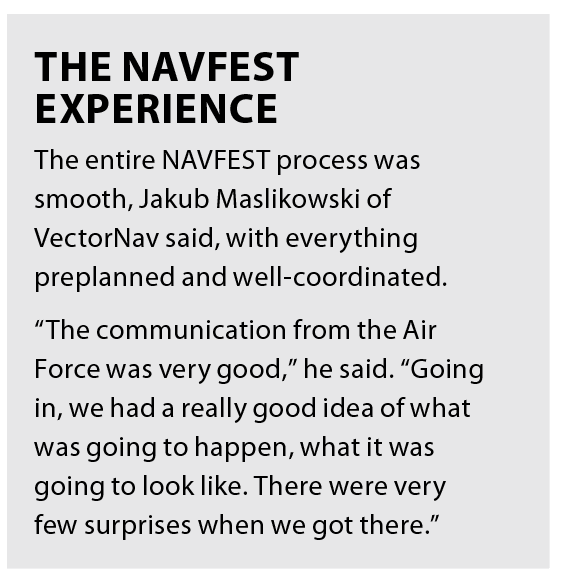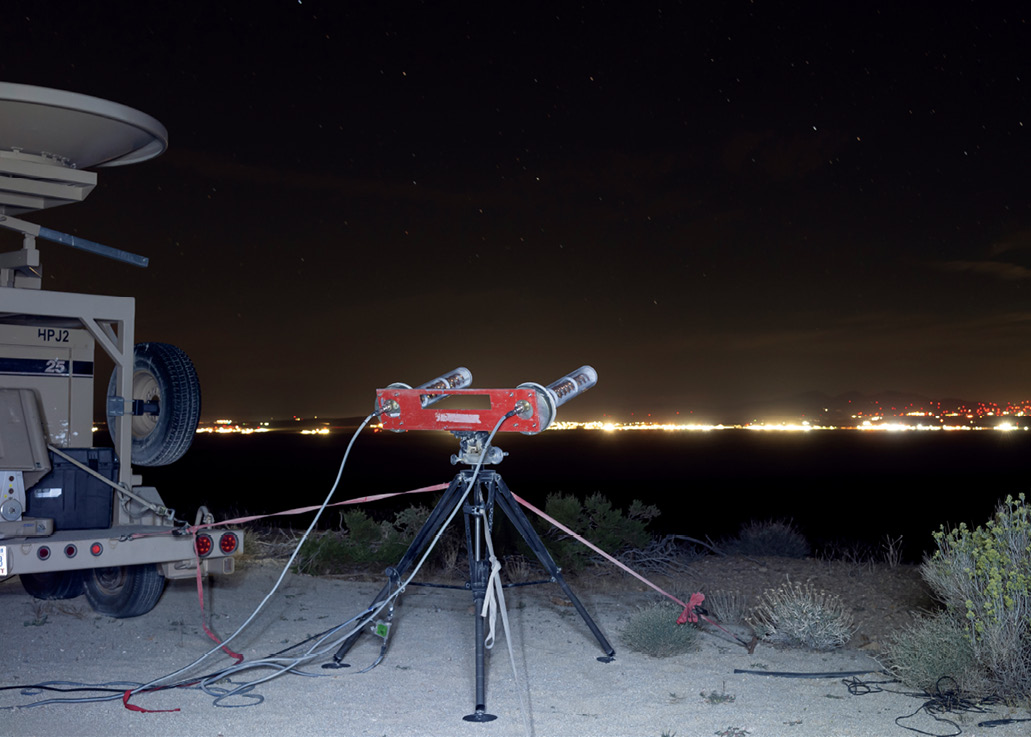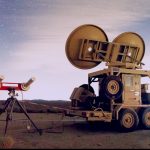During NAVFEST, participants can put their equipment through real-world spoofing/jamming scenarios, and use the data collected to improve current and future solutions. We recently spoke to a few attendees as well as the company behind the ground truth infrastructure about the event and why it’s so important.
The team at Hexagon | NovAtel tests equipment in a live sky environment every chance they get.
There’s just no replacement for testing in real-world scenarios, said Neil Gerein, vice president of product, aerospace and defense, at Hexagon Autonomy & Positioning division, particularly when it comes to evaluating how navigation solutions fare against spoofing and jamming. That’s why NAVFEST, held at White Sands Missile Range (WSMR) in New Mexico for the last 20 years and conducted by the United States Air Force’s 746th Test Squadron (746 TS), has become a must-attend event for the team.
NAVFEST 24 participants, which ranged from industry leaders like Hexagon to DOD entities to foreign nations, had the opportunity to test their equipment in GPS Electromagnetic Warfare (EW) scenarios as well as observe how other technologies performed, with eight nights of NAVWAR testing over a two week period. The 746 TS creates the testing scenarios and jamming while also providing accurate Time Space Position Information (TPSI) Reference, made possible in part by the Australia-based Locata system that provides critical positioning information in GPS-challenged environments.
“At NAVFEST 24, we tested products in a vehicle environment as well as a dismounted environment, and I got to experience firsthand how our equipment operates in those locations,” executive vice president, aerospace and defense at Hexagon Autonomy & Positioning division Stig Pedersen said, noting the team’s testing vehicle had about 25 different receivers in various configurations. “I now know the direct effect of jamming on our systems, and how we are able to mitigate jamming in real time. That’s very motivating.”
The threat to GNSS continues to grow, with attacks becoming more and more sophisticated. That’s translated into an increase in demand for robust navigation solutions that are resistant to jamming and spoofing, VectorNav VP, Business Development Jakub Maslikowski said, making the availability of such testing opportunities critical.
While the team at VectorNav receives plenty of customer feedback on product performance in various scenarios, helping them continuously improve their offerings, they wanted a deeper understanding of how their equipment and other PNT systems they integrate with hold up in contested environments. And that’s exactly what they got from their first NAVFEST experience in May.
“One of the motivations behind going to NAVFEST was to observe and collect data on how our INS filters react to bad GPS,” Maslikowski said. “How do we handle that GPS data in those environments, to what extent does it impact our filter, and how do we reject bad GPS? With the data collected at NAVFEST, we can improve that system. We can improve our ability to qualify GPS data, characterize it and reject disturbances.”
NAVFEST provides an opportunity these companies can’t get anywhere else, with the 746 TS working closely with each of them to create scenarios for their unique testing needs, whether in the air or on the ground. After two weeks of testing, participants gain a better understanding of the evolving threat and how to mitigate it.
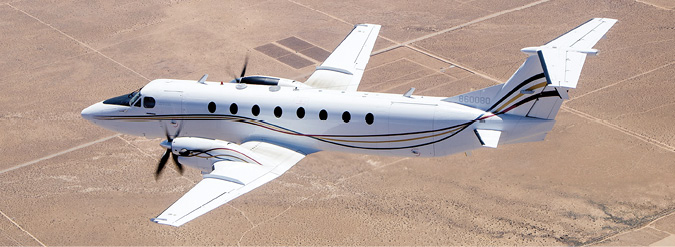
Upping the Ante
Over the years, the testing scenarios NAVFEST throws at participants have become more challenging, Gerein said, reflecting the changing environment warfighters face.
In the beginning, they were just jamming L1, he said, but over the years they’ve added frequencies and higher powered jammers, raising the game.
“And then we have inertial units,” Gerein said. “You have to use better and better inertials as the jamming effect gets higher and higher. So, we’re really testing the RF environment, throwing more at it. Every year, you can expect to have to run faster and faster to get that gold medal. And that’s just a reflection of the threats GNSS is facing.”

A Better Understanding
While simulation in a lab certainly has its place and benefit for testing, NAVFEST takes it to another level. Participants have the opportunity to see how their solutions respond to various jamming attacks in a controlled environment, and leave with a better understanding of what a warfighter might experience when GNSS goes down on the battlefield.
“White Sands is a desolate, very unfriendly place in terms of the environment. It’s not a place you want to stick around,” Pedersen said. “It’s very similar to the environment a warfighter uses our solutions in, and just having that dimension of testing is interesting. You can do a lot of testing on the bench, but until you’re actually out there in real time seeing the green light or the red light on the box, you don’t really understand it.”
The equipment also experiences different real world-variables, Maslikowski said, including vibration and temperature change, that you wouldn’t get in a lab.
“You’ve got to do it in real life,” Locata Co-Founder, President and CEO Nunzio Gambale said. “Simulators only take you so far, then you’re dependent on your inputs and, unfortunately, especially in adversarial situations, your enemy doesn’t conform to your assumptions in the sim.”
The level of granularity and real world exposure live sky testing at events like NAVFEST provides just can’t be replicated, Maslikowski said, and is a critical piece of any product development.
“That’s always been and will continue to be one of the hallmarks of our approach, the way we calibrate, qualify and define specification for our products,” he said. “They’re not generated from lab environments or through simulation; it’s through real world testing of hundreds and hundreds of units over time, over various dynamic scenarios, temperatures, you name it.”
And during NAVFEST, participants aren’t just testing performance on an antijam system or receiver; they’re testing everything.
“It allows you to test the end to end system in the actual environment, so there’s a lot of valuable testing even before they turn the jammers on,” Gerein said. “Do you have the install right? Are the inertials on your test equipment aligned correctly? That full-end testing is really valuable.”
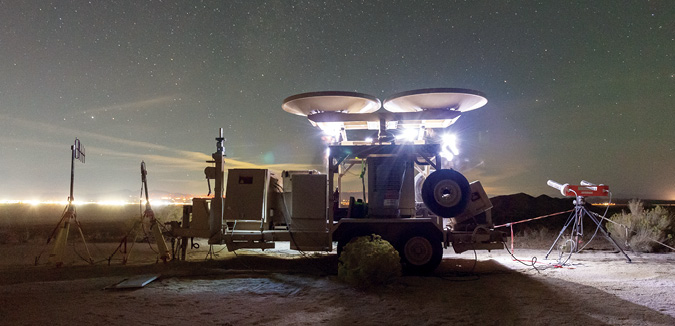
Testing a Range of Solutions
During NAVFEST, the team at Hexagon tests existing products shipping today for life cycle improvements as well as prototypes, Pedersen said.
“We test legacy products like the GAJT-410 and GAJT-710, we test our SPAN sensor fusion, and we test our regular GNSS boards,” Pedersen said. “But we also put new prototypes, and later prototypes on the truck. So, throughout the development cycle of our products, we expose them to this testing to verify their performance in an evolving environment but also to develop new algorithms and new ways of mitigating jamming in our new prototypes.”
They get as much data as they possibly can, Pedersen said, and use that data to improve their products year over year.
They also test solutions customers are using for truth systems, Gerein said, giving the team a chance to improve those systems as well.
VectorNav also brought various solutions for testing including high-end IMUs, M-Code receivers, antennas, and LEO satellite receivers, Maslikowski said. The team tested these solutions as standalone systems as well as in combination with other products to evaluate how they performed together in GNSS contested environments.
“We are a solutions provider. Part of what we do is make standalone products, but we also integrate with other PNT technologies, different aiding sources,” he said. “Leveraging those types of products can provide customers with a more resilient PNT solution.”
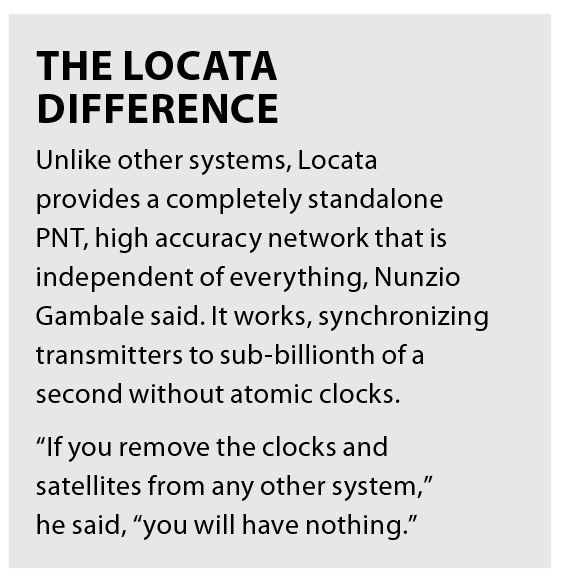
Providing the Infrastructure
Locata is also part of NAVFEST each year, with its specialized off-band pseudolite system serving as the non-GPS-based Positioning and Timing component of the 746 TS’s Ultra High Accurate Reference System. The company synchronizes transmitters to a sub-billionth of a second without atomic clocks, with terrestrially-based LocataLite transceivers transmitting well-synchronized signals to form a positioning network that operates in combination with GPS or totally independent of it.
Years ago, Locata was developing the technology for ground based transmitters when a researcher presented the work at a U.S. conference. That got the attention of an Air Force engineer, who came out to Australia to learn more about what Locata had cooking. The technology seemed to tick all the boxes for a testing architecture. It could transmit over long ranges, handle aircraft dynamics and deal with errors introduced over long ranges. That meeting led to the first successful Locata network and the initial trial deployment of a smaller, temporary network at White Sands.
Locata would eventually win the tender and deploy the technology at WSMR around 2016. The technology was tested over an intense two-week period, Gambale said, at different altitudes, speeds, trajectories, and configurations. It was initially tested for aircraft, but it quickly became clear it worked on the ground as well.
“There were demonstrations where it was getting lane level positioning in many areas across the range,” he said, “even though the network wasn’t designed for that.“
The Locata network now serves as the foundation for NAVFEST testing and is the sole provider of this critical synchronization capability to the Air Force.
“Our job is to provide them with the finest measurement tool we possibly can,” Gambale said, “and we are continuously developing and improving that capability. Our next generation devices are now in prototype, and they are incredibly more flexible and capable than our current devices. We continue to bring these systems to the industry, with our contributions pushing the boundaries of what is possible with PNT.”
Hexagon equipment also has been part of the ground reference at WSMR for years, an important component of testing.
“We have had a big footprint at test ranges for decades,” Gerein said. “Anytime you’re doing any testing in GNSS, you need to compare it to a truth trajectory because otherwise you don’t know what did or didn’t work. So that’s where our truth system comes into play. That was our first foray into these test situations, long before we had antijam equipment.”
A Unique Opportunity
Without the cooperation of the Air Force, there’d be no way to gather the kind of data and resulting knowledge participants gain each year from NAVFEST, Maslikowski said. Everyone who tests at NAVFEST fully understands the spoofing/jamming environments and how systems responded to specific conditions and technologies, a unique and highly valuable opportunity.
And this is critical as spoofing and jamming becomes more prevalent—on both the military and civilian side.
“You’re seeing this in all sorts of different locations around the world, and not necessarily in NAVWAR scenarios,” Maslikowski said. “There’s all sorts of systems and aircraft being impacted by this. This is no longer a strictly defense issue and problem, it’s commercial as well. So, the value add of being able to provide robustness to these types of scenarios is not limited to customers operating in war zones. This is very much becoming more and more relevant to the commercial sector as well.”
Both Hexagon and VectorNav will continue to focus on this type of testing for the foreseeable future, with antijam capabilities now an essential part of product roadmaps and development. Pedersen even described it as “the single most important input into our software.”
“Antijam saves people’s lives,” Gerein said. “Jamming isn’t going away. If certain conflicts settle down in the world, it’s not like people are going to say I’m going to stop jamming. Jamming is here to stay.”
